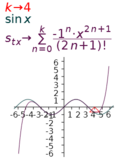7.7 Plotting Taylor's Series
This example shows how the limit value in a summation can be bound to
a real definition.
The Taylor series for sin x is given by


How close to sin x is the 5-term series expansion?
To answer this, plot both the series and sin x.
(You'll have to plot the summation using the function definition

To investigate further the effect of changing the limit of the summation, replace it with a variable that is defined elsewhere on the display. Then plot both the series function and the variable.
These functions need to be added to the plotter:
-

s_t(x)→∑0, k, -1^n⋅x^(2⋅n+1)÷(2⋅n+1) !ⅆn -

sin x -

k→4
The variable definition

